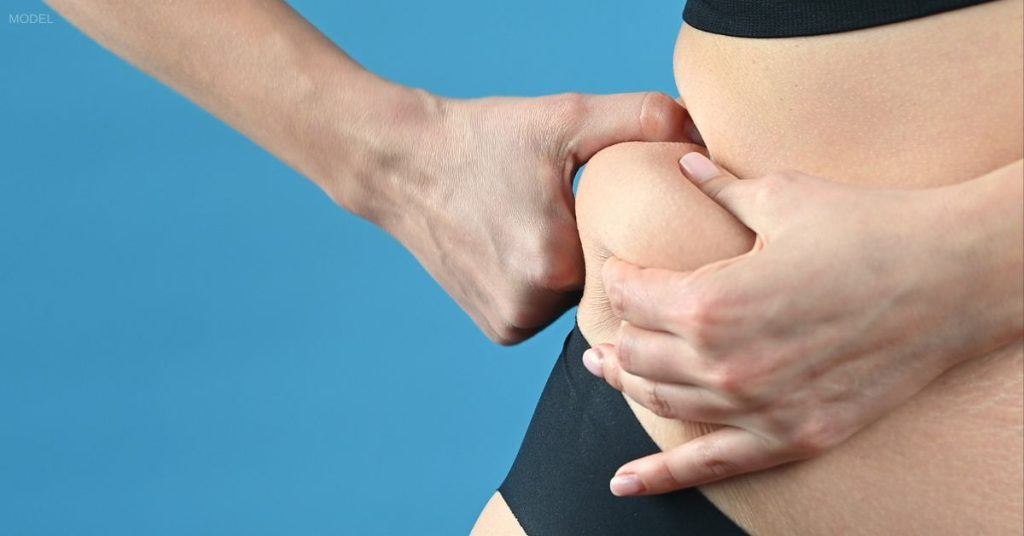Imagine slimming down an area like your abdomen while adding natural-looking, youthful volume to your face, lips, breasts, or buttocks. With fat transfer, it’s possible. And by using your own fat cells, the procedure offers an extremely long-lasting, biocompatible option for cosmetic enhancement.
Intrigued? Let’s look at how fat transfer works, how long the results last, and some of the factors that affect the longevity of your results.
How Does Fat Transfer Work?
Fat transfer is an intricate, 3-step process:
- Harvesting fat from the donor area: Using a specialized liposuction technique, the surgeon extracts fat cells carefully to maximize their viability.
- Purifying the harvested fat: The next step is purification. Not all the extracted material will be pure fat—it can contain other substances, such as blood or tissue fluid, which must be removed. Purification ensures that the highest quality, most viable fat cells remain.
- Injecting into the target area: Finally, the purified fat is ready to be injected into the target area. The surgeon will use specialized injection techniques to distribute the fat cells evenly and to achieve a natural look.
What Areas Can Fat Transfer Enhance?
The treatment typically delivers the most noticeable benefits in the following areas:
- Fat Transfer to the Breast: This procedure offers a natural approach to breast enhancement without the need for implants. Only a modest size increase is possible with fat transfer, so this option isn’t suitable for everyone. Learn more in this related blog post.
- Fat Transfer to the Buttocks: Often called a Brazilian butt lift, this procedure can add fullness and shape to your backside.
Further, whether due to injury or prior surgery, fat transfer can fill areas where the soft tissue is missing or irregular.
How Long Does It Take for Fat Transfer To Work?
Initial results can be seen immediately, but the final results are typically visible after 3 to 6 months.
How Long Do Fat Transfer Results Last?
Fat transfer is considered a permanent procedure, offering long-lasting outcomes that make it well worth the investment for most patients. However, several factors affect the transfer’s durability:
Stabilization and Blood Supply
During the initial phase after the procedure, the transferred fat cells stabilize and develop a new blood supply. This biological process, known as angiogenesis, is essential for ensuring the longevity of the transferred fat. The newly transferred cells become integrated with the surrounding tissue, and once they’re stable, they behave just like the other fat cells in the target area.
Lifestyle and More
Age, lifestyle, and the surgeon’s skill can impact how long the results will last. Proper post-operative care, healthy lifestyle choices such as a balanced diet and regular exercise, and avoiding significant weight fluctuations can further preserve results.
The Science of Effective Fat Transfers
While fat transfer procedures have become increasingly refined and sophisticated, one of the primary concerns is that not all transferred fat survives—a phenomenon known as fat necrosis.
Why Some Transferred Fat Doesn’t Survive
Fat cells are delicate, living tissues that require a blood supply to survive. When moved from a donor site to a new location, they temporarily lose their blood supply and must integrate into a new area. Some fat cells won’t survive this transition because they don’t establish a new blood supply fast enough or because of the body’s natural metabolic processes.
The Role of the Surgeon’s Technique
The surgeon’s expertise plays a crucial role in mitigating this risk. In my practice, I use state-of-the-art fat harvesting, purification, and reinjection techniques to facilitate more successful integration. Attention to detail during each step provides the best possible outcome and minimizes the need for repeat procedures.
Repeat Procedures
In some cases, a follow-up procedure may still be necessary to achieve desired results. These are generally less extensive than the initial surgery and are aimed at fine-tuning the results.
Low Maintenance, High Satisfaction
One of the standout advantages of fat transfer over other aesthetic treatments, such as injectable dermal fillers, is the low maintenance involved. Once the desired results are achieved, you won’t need follow-up treatments, making it both cost-effective and convenient in the long term. While the initial investment might be higher, the durability of the results makes it a savvy choice for those looking for permanent enhancement.
Ready To Take the Next Step?
If you’d like to learn more about how fat transfer can help you achieve your aesthetic goals, we invite you to call our office at (208) 676-8346 or request a consultation.




Leave a Reply